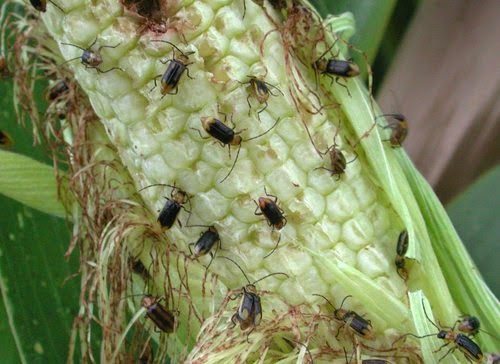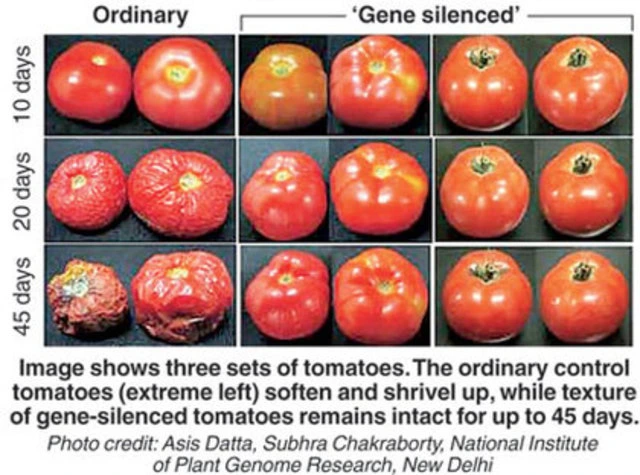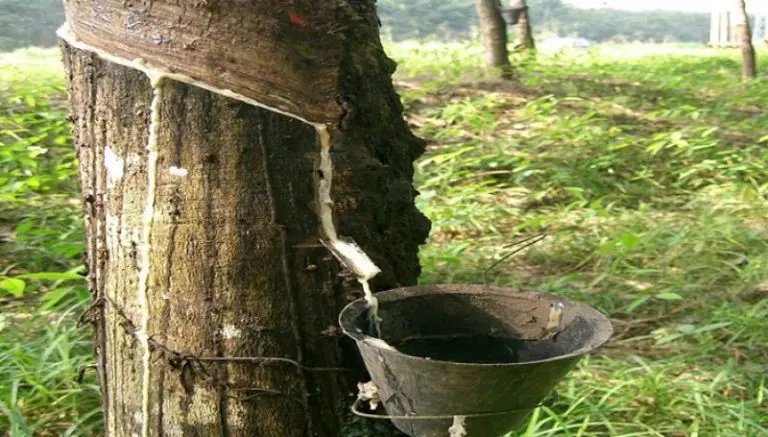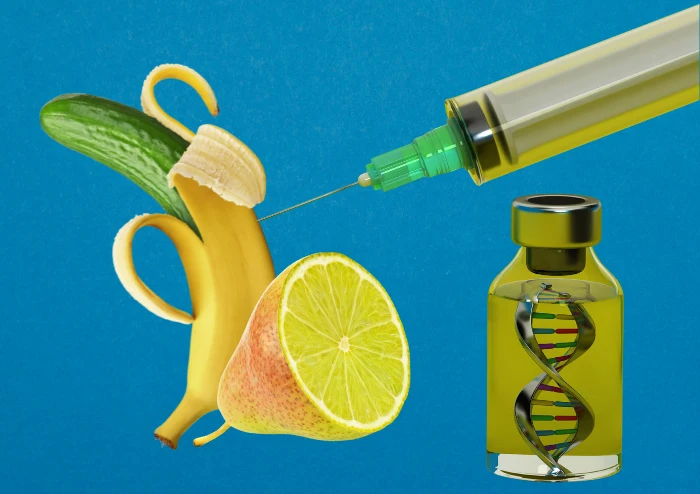Genetic modification isn’t just about animals that glow in the dark – it extends deep into the world of plants, creating a tapestry of the astonishing, the peculiar, and the simply mind-boggling.
Brace yourself for a journey through the realm of genetically modified plants that have graced our plates and gardens, often without our knowledge.
As we delve into this captivating list, you’ll discover that genetically modified plants aren’t just a distant concept; they’re already a part of our everyday lives.
Some are engineered to solve pressing agricultural challenges, while others push the boundaries of imagination.
Get ready to explore the captivating world where science meets nature in unexpected ways.
9: Bug-Killing Corn – Maize's Marvelous Makeover

Imagine a cornfield plagued by the relentless corn-borer, a formidable adversary that has farmers wrestling with crop losses.
Enter the genius of genetic modification, and suddenly, corn becomes a superhero.
The genetic alteration introduces the Bt protein, a natural insecticide that thwarts the corn-borer’s destructive rampage.
The Genius Behind the Bt Protein: Nipping Pest Problems in the Bud
The introduction of the Bt protein marks a groundbreaking shift in pest control. Derived from the bacterium Bacillus thuringiensis, this protein serves as a guardian, protecting the corn against the voracious appetites of the corn-borer.
As this modified crop mingles with conventional corn, it forms a formidable partnership, ensuring the corn-borer’s threat remains minimal.
Striking a Delicate Balance: The Ratio that Saves the Day
In a strategic twist, farmers deploy an ingenious ratio – 80% genetically modified corn to 20% conventional corn. This calculated blend prevents the corn-borer from developing an immunity to the Bt protein.
It’s a dance of science and strategy, allowing us to harness the potential of genetic modification while preserving its long-term effectiveness.
A Billion-Dollar Impact: Changing the Game for Farmers
Since its introduction in 1996, bug-killing corn has emerged as a triumphant ally for farmers in states like Illinois, Iowa, Minnesota, Nebraska, and Wisconsin.
The impact is monumental, with estimated savings of a staggering $7 billion.
This genetically modified marvel has elevated agricultural resilience, showcasing how science can tip the scales in favor of sustainable and bountiful harvests.
A Glimpse into a Transformed Tomorrow
The bug-killing corn’s success story is just the beginning of our exploration into the world of genetically modified plants. As we journey deeper into this realm, you’ll uncover plants that defy norms, challenge conventions, and redefine possibilities.
Stay with us as we peel back the layers of nature’s most astonishing and bizarre genetic makeovers. With each revelation, you’ll witness the remarkable marriage of science and nature, shaping a tomorrow that’s as fascinating as it is unexpected.
8. Evergreen Apples: Defying the Browning Fate
In the realm of genetically modified marvels, even the simple act of slicing an apple becomes a journey into scientific ingenuity.
Prepare to unravel the tale of non-browning apples, where genetic modification transforms the browning process from a swift inevitability to a controlled phenomenon.
Picture this: you cut into a crisp apple, only to be met with the sight of rapid browning, as if nature itself is conspiring against your snack.
The phenomenon, known as oxidation, takes a toll on the visual appeal and freshness of your fruit. But what if there were apples that defied this culinary nemesis?
The Science Behind the Silence
Meet the Arctic Golden and Arctic Granny apples – a dazzling creation by Okanagan Specialty Fruits in Canada.
Through a revolutionary gene-silencing process, these apples are imbued with the power to resist the chemical reaction that triggers browning.
It’s a biological feat that transforms the fate of these fruits, preserving their pristine appearance even after being sliced.
The gene-silencing process at the heart of this transformation is nothing short of remarkable. By suppressing the genes responsible for triggering oxidation, scientists have created a masterstroke of genetic modification.
The result is a culinary revelation that leaves these apples looking freshly sliced for an extended period.
Cultivating Culinary Imagination: A Path to Regulation
In a landmark decision in 2015, the US Department of Agriculture took a pivotal step by deregulating these engineered apples.
This move set the wheels in motion for these non-browning wonders to potentially grace our tables in the future, transforming the way we experience and enjoy this beloved fruit.
A Glimpse of Tomorrow’s Orchard: Shaping a Crisp Future
As the journey of non-browning apples unfolds, it invites us to reimagine the culinary landscape.
These apples are more than just a novelty; they exemplify the potential of genetic modification to address everyday challenges.
Join us as we venture deeper into the world of genetically modified marvels, where the boundaries of nature are pushed, and the ordinary takes an extraordinary turn.
7. Flavr Savr Tomato: The Bittersweet Tale of a Genetically Modified Farewell
In the realm of genetic modifications, even the most brilliantly engineered creations can experience a fate as captivating as it is cautionary.
Prepare to dive into the curious narrative of the Flavr Savr Tomato, a once-promising marvel that danced between potential and practicality, leaving an indelible mark on the genetic landscape.
Meet the Flavr Savr Tomato, a name that echoes with a certain infomercial charm. The intriguing nomenclature might have been a double-edged sword, capturing attention while also conjuring skepticism.
Yet, it’s this very aura that adds a layer of mystique to the tale of this genetically modified wonder.
The Quest for Tomato Transformation: A Vision of Longevity
Borne from the visionary minds at Calgene, the Flavr Savr Tomato sought to redefine the realm of freshness.
Engineered to exhibit a longer shelf-life and a robust exterior, it promised to endure the rigors of harvest without sacrificing the quality of the product. The concept was audacious and promising, an attempt to infuse convenience into the fabric of nature.
A Soft Reality: Balancing Longevity and Sensory Experience
As the Flavr Savr Tomato emerged, it demonstrated the remarkable capacity to prolong its shelf life – a testament to genetic engineering’s potential.
However, the taste of success was laced with an unforeseen twist. While it retained its structural resilience, the tomato’s innate softness persisted, requiring handling akin to its non-modified counterparts.

The Ebb and Flow of Innovation: A Journey Marked by Fluctuations
Even as the tomato evolved, with flavors maturing over time, the advancement carried a price – a shift that reflected in its market cost.
This rise in pricing sent ripples through its journey, reshaping its trajectory and ultimately leading to the fading of both Calgene and its pioneering Flavr Savr Tomato.
The Flavr Savr Tomato’s saga weaves a tale of ambition and adaptation, illustrating the intricate dance between scientific innovation and the expectations of the culinary world.
In its rise and fall, we glimpse the complexities of genetically modified creations and the unforeseen consequences that shape their destiny.
As we bid adieu to the Flavr Savr Tomato, we’re reminded that the world of genetic modifications is one of constant exploration. Each innovation, each attempt, leaves a mark on the canvas of scientific progress.
Join us as we continue to unravel the stories behind the most remarkable and sometimes enigmatic genetically modified wonders, forging a path toward deeper understanding and insight.
6. Super Bananas: A Golden Hope Against Vitamin A Deficiency
Amid the bustling world of genetic modifications, a silent transformation has been underway within the realm of bananas – a beloved household fruit that stands as an emblem of simplicity.
Yet, beneath their unassuming appearance, a breakthrough known as the “super banana” is quietly rewriting the narrative of this humble staple.
Bananas: Nature’s Evolutionary Wonder and Genetic Frontier
Bananas, with their familiar contours and inviting sweetness, have long graced our tables. However, these fruit companions of ours, while appearing unchanged, have ventured into the realm of genetic modification.
Contrary to popular belief, not all bananas are genetically modified, although there are serious problems facing the global banana supply, but that hasn’t stopped scientists from exploring the possibilities within this botanical treasure trove.
Enter the realm of the “super banana,” an innovation that appears no different from its naturally occurring counterpart yet holds within it an extraordinary potential.
This remarkable creation stands as a beacon of hope against a formidable adversary: vitamin A deficiency.
Through meticulous genetic modifications, these unassuming fruits have been imbued with elevated levels of vitamin A, a nutrient crucial for human health.
A Solution Rooted in Science and Compassion: Tackling Vitamin A Deficiencies
The genesis of the super banana is not driven by mere scientific curiosity; rather, it emerges as a response to a pressing humanitarian concern.
Thousands face the specter of fatal vitamin A deficiencies, a nutritional gap that the modified bananas aim to bridge. This act of genetic intervention is propelled by a profound empathy for those vulnerable to the consequences of deficiency.
As the laboratory triumph of the super banana takes shape, it embarks on a journey from experimentation to practical application.
The target destinations for this botanical innovation, Rwanda, Kenya, Tanzania, and Uganda, bear the weight of expectation as trials pave the way for a potential revolution in nutritional sustenance.
The Future Beckons: Paving the Way for Change
With each bite of the super banana, a new chapter unfolds in the narrative of genetic modification. As the world watches with bated breath, researchers strive to refine and validate their creation through trials.
The promise of enhanced vitamin A intake, once a distant dream, edges closer to reality, ushering in a new era where the boundaries between science and compassion blur to create lasting impact.
The super banana stands as an embodiment of both scientific innovation and societal responsibility, intertwining the realms of genetics and human welfare.
As it charts its course from laboratories to households, this unassuming fruit resonates as a symbol of hope, a testament to the potential of genetic modifications to address critical global challenges.
Join us as we delve deeper into the world of genetically modified wonders, uncovering the remarkable stories that shape our understanding of science and humanity’s journey forward.
5. Pollution Fighting Plants: Lab Grown Green Warriors

In a world besieged by mounting pollution levels, a surprising savior emerges from the roots of the earth – plants.
Unveil the astonishing journey where scientists and researchers harness the power of genetic modification to transform grass and trees into formidable pollution fighters, ushering in a new era of environmental resilience.
As pollution casts an ominous shadow over our planet, concern swells for the well-being of both humanity and nature. Amidst this challenge, a groundbreaking revelation emerges – the inherent potential of plants to become agents of cleansing and renewal, heralding a future where genetic modification takes center stage.
Botanical Allies: The Unexpected Heroes of Toxin Battle
Nature’s green guardians, grass and trees, step forth as unsung heroes in the quest to counteract pollutants. The spotlight shifts to these seemingly ordinary entities, as scientists explore their potential to become nature’s own purification systems, capable of absorbing and neutralizing toxins that threaten our ecosystems.
Unlocking Plants’ Pollution-fighting Prowess
Phytoremediation, a process involving plants’ ability to detoxify soil, air, and water, is not a novel concept.
Yet, its implementation has faced hurdles due to its slow pace and substantial costs.
Enter genetic modification – an innovation that sparks optimism by accelerating the pollution-cleansing capabilities of plants to unprecedented levels.
Genetically modified plants, a testament to human ingenuity, unleash a rapid and dynamic response to pollutants.
Unlike their natural counterparts, these engineered wonders exhibit enhanced processing of carcinogens, presenting a paradigm shift in the effectiveness of phytoremediation.
Cultivating Hope: Phytoremediation’s Glorious Potential
Amidst the whir of genetic manipulation, a gleaming prospect emerges – the potential for plants to lead a global charge against pollution.
As these engineered botanical soldiers swiftly and effectively tackle contaminants, the concept of phytoremediation evolves from a slow and costly endeavor to an accessible and eco-friendly solution.
A Glimpse into Tomorrow: Clearing Skies and Cleansed Earth
Envision a future where urban landscapes teem with trees that stand not only as sentinels of green beauty but also as steadfast defenders against pollution.
As the sun pierces through skies unburdened by toxins and waterways ripple with newfound purity, genetically modified plants herald a brighter tomorrow for both humanity and the environment.
The pursuit of pollution-fighting plants isn’t merely an endeavor in genetic tinkering; it’s a harmonious symphony of human innovation entwined with nature’s inherent resilience.
As we embark on this transformative journey, we find ourselves at the crossroads of scientific exploration and environmental stewardship, bound together by a shared aspiration – to cultivate a planet where flora and fauna coalesce to cleanse, renew, and restore.
4. Venomous Cabbage: A Provocative Marvel of Genetic Engineering
Prepare to venture into the realm of extraordinary botanical innovation, where science and nature converge in an unexpected and daring manner.
Discover the enigmatic world of venomous cabbage – a curious creation that blurs the boundaries between predator and prey, scorpion and caterpillar, igniting both awe and skepticism.
Scorpion Venom and Cabbage: A Peculiar Partnership
In an audacious twist of genetic engineering, scorpion venom and humble cabbage entwine their destinies to forge a new era of pest control.
The fusion of these seemingly incongruous elements may raise eyebrows, yet it holds the potential to revolutionize the battle against a notorious adversary – caterpillars.
The concept of venomous cabbage, though at first glance paradoxical, reveals a captivating strategy.

Picture the scorpion’s venom, notorious for its paralyzing effect, woven into the very fabric of cabbage leaves. This intricate partnership aims not to harm humans, but to confront a specific menace – the caterpillar.
Nature’s Game of Deception: The Art of Luring the Culprit
Intricately orchestrated, the venomous cabbage sets an ingenious trap for caterpillars. As these unsuspecting herbivores partake in their meal, the infused venom swiftly infiltrates their bodies, delivering a nerve poison that induces paralysis.
The diabolical twist unfolds as the paralyzed caterpillar becomes a host to an engineered virus, heralding its ultimate demise.
The venom’s potent properties catalyze an unrelenting chain of events.
Paralyzed and defenseless, the caterpillar succumbs to the viral onslaught. The engineered virus ravages its host, sealing its fate and orchestrating an ecological dance that pits science against nature’s intricacies.
Ecological Ripples: Weighing the Consequences
As venomous cabbage ventures from laboratory to reality, ecological concerns emerge.
The cascading effect of engineered venom targeting caterpillars triggers a chain reaction that impacts delicate ecosystems. The profound question looms – will this ingenious solution lead to a harmonious equilibrium or disrupt the delicate balance of nature?
Venomous cabbage encapsulates the dual nature of scientific innovation – provocation and progress.
While its potential to control pests appears promising, the collateral effects on non-target species cast a shadow of uncertainty.
The journey of venomous cabbage extends beyond laboratory experimentation, forging a path towards a future where humanity’s pursuit of solutions coexists harmoniously with nature’s intricate tapestry.
As we navigate the uncharted realms of genetically modified organisms, we stand at the precipice of an era where ecological balance hinges on the duality of innovation and responsible stewardship.
3. Genetically Modified Trees
Prepare to journey through the verdant landscapes of genetic exploration, where towering sentinels of nature undergo transformation at the hands of human ingenuity.
Delve into the compelling narrative of genetically modified trees – a frontier where innovation intertwines with ecological stewardship, shaping the future of industries and ecosystems.
The Hybrid Odyssey: When Rubber Meets Cork
In a tale driven by consumer yearnings and innovation, the worlds of rubber and cork converge in an unexpected fusion. Witness the intriguing metamorphosis of the rubber cork tree, a response to the discerning tastes of wine connoisseurs who sought an alternative to traditional cork closures.
SABIC innovative plastics orchestrated a genetic marriage, blending the attributes of the rubber tree with the cork tree, resulting in a remarkable creation – a tree yielding a cork that straddles the realms of rubber and cork.
This visionary endeavor mirrors the delicate dance of satisfying consumer desires while orchestrating botanical synergy.

Paper Pioneers: Unveiling Trees of Transformative Potential
From ink on paper to the depths of biofuel innovation, genetically modified trees wield their transformative potential.
Enter the realm of paper production, where scientific minds from the University of British Columbia, University of Wisconsin-Madison, and Michigan State University unite to engineer trees primed for a sustainable revolution.
These arboreal pioneers are designed to facilitate the efficient breakdown necessary for paper and biofuel synthesis, heralding a paradigm shift in production processes.
As these engineered trees gracefully yield their fibers, they present a compelling solution to reduce pollutants and resource consumption in the paper industry, offering a greener horizon.
The narrative of genetically modified trees unveils a harmonious symphony between innovation and ecological harmony. Amidst the tapestry of genetic exploration, these arboreal wonders embrace a dual role – enhancing industrial efficiency while nurturing the delicate equilibrium of ecosystems.
Whether it’s the convergence of rubber and cork or the pursuit of sustainable paper production, genetically modified trees symbolize a progressive stride towards coexisting with nature while harnessing its limitless potential.
The Canopy of Tomorrow: Navigating the Future of Tree Manipulation
As humanity strides into the realm of genetically modified trees, an ethical nexus emerges, challenging our responsibilities as stewards of the natural world.
The alteration of these majestic giants ignites conversations about ecological consequences, potential disruptions to local ecosystems, and the moral boundaries of scientific intervention.
As we tread the boundary between innovation and safeguarding the environment, the journey of genetically modified trees invites us to explore a future where progress is harmonized with ecological integrity.
Amidst the branches of genetically modified trees lies a promise – a promise of sustainability, ingenuity, and a reimagined relationship between humanity and the natural world. As these genetic pioneers flourish in landscapes of possibility, they beckon us to envision a world where forests, industries, and environmental harmony thrive in unison.
As science and nature continue their embrace, the genetic symphony of trees resounds with the hope of a brighter and more balanced future.
2. Super Carbon-Capturing Plants: Guardians of the Carbon Realm
Amidst the intricate dance of carbon production and absorption, an extraordinary alliance emerges between nature’s green architects and the imperatives of a warming world.
Journey into the heart of genetic innovation, where plants ascend to the role of guardians, entrusted with a monumental task – capturing and taming the relentless surge of carbon emissions.
A World Adrift in Carbon: A Global Imperative
As the relentless wheels of human progress churn, they emit a staggering torrent of carbon – 9 gigatons annually – into the fragile embrace of our atmosphere.
Yet, hope resides in the fact that approximately 5 gigatons are embraced by the green arms of vegetation, an intricate symphony of absorption that leaves 4 gigatons adrift, weaving an intricate tapestry of climate instability.
This delicate equilibrium demands attention, as it fosters fears of global warming and the looming specter of the greenhouse effect.
Genetic Symphony: Enlisting Plants as Carbon Sentinels
In a bid to fortify nature’s carbon-capturing ranks, a symphony of genetic tinkering is orchestrating an unconventional collaboration – super carbon-capturing plants. At the nexus of botanical biology and cutting-edge science, researchers channel their energies into the creation of bio-energy crops with expansive root systems primed for a unique purpose – to corral and sequester carbon.
While leaves, branches, and flowers play their part, the roots stand out as steadfast carbon custodians, capable of harboring carbon for extensive periods.
The Root’s Timeless Repository: Unleashing the Power of Carbon Storage
Unlock the remarkable potential of roots, a hidden reservoir capable of defying the ticking clock of carbon’s release. The genius of genetic modification lies in its capacity to amplify the root’s natural capabilities, sculpting it into an unparalleled fortress against carbon’s relentless advance.
As these bio-energy crops flourish, their roots delve deep into the earth, capturing and storing carbon with unparalleled efficiency, rendering the atmospheric excess of 4 gigatons a memory of the past.
The journey of super carbon-capturing plants is more than an innovation – it is a beacon of hope for a world grappling with its carbon legacy.
These engineered sentinels emerge as a pivotal cornerstone in humanity’s quest for a sustainable equilibrium, a living testament to the power of scientific ingenuity and harmonious coexistence with nature.
With each root’s embrace of carbon, a promise is woven into the fabric of our future – the promise of a cleaner, greener, and more balanced world, poised to stand resilient against the tide of climate uncertainty.
The Delicate Dance of Balance: Navigating Ethical Horizons
As we stand at the precipice of reshaping nature’s guardians, the ethical contours of our intervention come into sharp focus.
The journey of super carbon-capturing plants necessitates introspection, prompting us to weigh the benefits of carbon capture against potential ecological impacts.
The quest for climate stability prompts a dialogue on striking the right balance between scientific innovation, environmental harmony, and our responsibility as stewards of the Earth.
The narrative of super carbon-capturing plants illuminates a transformative chapter in the ongoing saga of our planet’s resilience.
As these genetic marvels unfurl their roots and weave their carbon-trapping magic, they breathe life into a narrative of hope, unity, and adaptation.
With each instance of carbon captured, they inscribe a tale of triumph over climate adversity, reminding us that in the intricate choreography of carbon and life, science and nature are bound inextricably – shaping a future that stands steadfast against the shadows of carbon’s menace.
1. Land Mine Detecting Plants: Yes, You Read That Right!
The remnants of wars echo far beyond the battlefield, and beneath the soil.
In the crucible of innovation, a groundbreaking alliance between plant life and science emerges, unveiling an extraordinary endeavor that promises to rewrite the narrative of landmine detection. Traverse the realm of Danish ingenuity and the promise of biotechnology, as the humble plant takes on an unprecedented role as a sentinel of safety.
In the aftermath of warfare, an unsettling reality dawns – landmines, scattered beneath the earth’s surface, pose an ongoing threat long after the battles have ceased.
As nations grapple with the legacy of conflict, the search for an effective, accessible, and affordable method of landmine detection becomes an imperative pursuit.
Enter the remarkable realm of Aresa Biodetection, where Danish researchers unfurl the astonishing potential of plants as landmine sentinels.
A testament to the symbiotic relationship between science and nature, these engineered plants bear witness to the invisible compounds that betray the presence of buried landmines. Through an ingenious color-changing response, these plants metamorphose into living detectors, revealing the otherwise concealed signatures of danger.
A Vision of Hope: Transforming Detection Dynamics
Traditional landmine detection endeavors are marked by both exorbitant costs and inherent risks.
The advent of landmine-detecting plants heralds a seismic shift, offering a solution that transcends financial barriers while preserving human lives.
With the current cost of landmine detection and clearance skyrocketing to $2,000 per mine, these vegetative sentinels have the potential to revolutionize the landscape of humanitarian demining efforts, safeguarding lives, resources, and invaluable peace of mind.
Drones and Plants: A Biomechanical Partnership of Innovation
The saga of landmine-detecting plants merges seamlessly with the frontiers of technology. New-age drones, equipped with the remarkable ability to identify signs of hidden danger, dance in tandem with the color-changing plants.
This dynamic synergy yields an unprecedented partnership – a convergence of aerial precision and vegetative vigilance that can navigate hazardous terrains, identify potential threats, and aid in the safe removal of landmines.
In a world grappling with the scars of conflict, the emergence of landmine-detecting plants resonates as a beacon of hope and transformation.
As these unassuming guardians of safety infiltrate the landmines’ secretive domain, they inscribe a new chapter in the annals of conflict resolution and human protection.
Beyond their botanical essence, these plants embody the boundless potential of human ingenuity and the indomitable spirit of progress.
The intersection of science, safety, and nature raises crucial ethical questions as landmine-detecting plants step onto the global stage. As we harness the might of biotechnology to mitigate human suffering, a dialogue on environmental impact, unintended consequences, and responsible deployment becomes paramount.
The journey of these plants epitomizes the delicate equilibrium between innovation and safeguarding the planet’s delicate balance.
In the heart of the soil, a remarkable partnership unfolds – between the intricate choreography of plant life and the brilliance of human innovation. As landmine-detecting plants unfurl their mission of safeguarding humanity, they paint a vivid portrait of hope, resilience, and a world united in the pursuit of safety.
Each color-changing transformation, every collaborative endeavor, becomes an emblem of progress and a testament to the extraordinary potential of science to redefine the boundaries of what is possible.
More To Discover
- 10 Foods That Originally Looked Totally Different Until We Changed Them
- The Hidden Agricultural Heroes Powering Our Everyday Lives: Top 5 Genetically Modified Crops
- Silkworms Challenge Nylon and Kevlar in Environmental Showdown: Genetically Enhanced Caterpillar Set to Revolutionize Green Fabric Production
- Snapdragon DNA Meets Tomato: Grow a Super Healthy Purple Marvel in Your Garden

In the Tapestry of Innovation: Unveiling the Marvels of Genetically Modified Plants
The world of genetic modification is a captivating tapestry, woven with threads of innovation, ingenuity, and a relentless pursuit of progress.
From the intriguing to the astounding, the 9 most bizarre genetically modified plants bear witness to the power of human imagination, stretching the boundaries of what is possible and redefining our relationship with the natural world.
Each of these engineered marvels tells a unique story – a narrative of scientific curiosity, environmental stewardship, and the quest to address pressing challenges that transcend borders.
As we traverse the landscape of bug-killing corn, non-browning apples, super bananas, cancer-fighting tomatoes, pollution-fighting plants, venomous cabbage, genetically modified trees, super carbon-capturing plants, and landmine-detecting flora, a common thread emerges – the audacious spirit of exploration that propels humanity forward.
Yet, beyond the wonder and awe, lies a realm of ethical contemplation. The dance between progress and responsibility underscores the importance of thoughtful consideration and transparent dialogue.
These genetically modified plants remind us that the path to a sustainable future requires not only scientific prowess but also a deep reverence for the delicate balance of our ecosystems.
As we stand at the crossroads of innovation and stewardship, let us embrace the opportunity to shape a future that harmonizes with nature.
These astonishing creations illuminate the potential for scientific breakthroughs to serve as catalysts for positive change, offering solutions to complex challenges that have long perplexed us. They beckon us to be vigilant custodians of our planet, guarding against unintended consequences while harnessing the marvels of genetic modification for the greater good.
In the end, the story of these genetically modified plants is a testament to the indomitable spirit of human inquiry and our unwavering commitment to nurturing a world that thrives with biodiversity, resilience, and sustainability. As we gaze upon these botanical wonders, we are reminded that our shared journey is marked not only by scientific discovery, but also by a profound connection to the intricate web of life that envelops us all.
In the symphony of innovation and nature, may we find harmony, purpose, and a collective determination to cultivate a future brimming with possibility and promise.




















